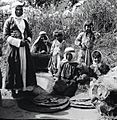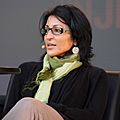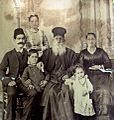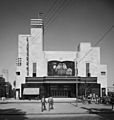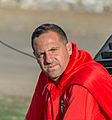Palestinians facts for kids
| Total population | |
|---|---|
| c. 13,000,000 | |
| Regions with significant populations | |
| State of Palestine | 4,750,000 |
| – West Bank | 2,930,000 (of whom 809,738 are registered refugees (2017)) |
| – Gaza Strip | 1,880,000 (of whom 1,386,455 are registered refugees (2018)) |
| Jordan | 2,175,491 (2017, registered refugees only)–3,240,000 (2009) |
| Israel | 1,890,000 (60% of Israeli Arabs identify as Palestinians (2012)) |
| Syria | 552,000 (2018, registered refugees only) |
| Chile | 500,000 |
| Lebanon | 174,000 (2017 census)–458,369 (2016 registered refugees) |
| Saudi Arabia | 400,000 |
| Qatar | 295,000 |
| United States | 255,000 |
| United Arab Emirates | 91,000 |
| Germany | 80,000 |
| Kuwait | 80,000 |
| Egypt | 70,000 |
| El Salvador | 70,000 |
| Brazil | 59,000 |
| Libya | 59,000 |
| Iraq | 57,000 |
| Canada | 50,975 |
| Yemen | 29,000 |
| Honduras | 27,000–200,000 |
| United Kingdom | 20,000 |
| Peru | 15,000 |
| Mexico | 13,000 |
| Colombia | 12,000 |
| Netherlands | 9,000–15,000 |
| Australia | 7,000 (rough estimate) |
| Sweden | 7,000 |
| Algeria | 4,030 |
| Languages | |
| Palestine and Israel: Palestinian Arabic, Hebrew, English and Greek Diaspora: Other varieties of Arabic, the vernacular languages of other countries in the Palestinian diaspora |
|
| Religion | |
| Majority: Sunni Islam Minority: Christianity, Samaritanism, Druze, Shia Islam, non-denominational Muslims |
|
| Related ethnic groups | |
| Other Levantines, other Semitic-speaking peoples, Jews (Ashkenazim, Mizrahim, Sephardim), Assyrians, Samaritans, other Arabs, and other Mediterranean peoples. | |
The Palestinian people or just Palestinians are the Arab people from the West Bank and the Gaza strip, which are also called the Palestinian Territories, or Palestine.
The people called "Palestinians" today are Arabs, but in the past, "Palestinians" could also be used as a name for Jewish people who lived in Palestine.
Some well known Palestinians are:
- Yasser Arafat, Leader of PLO
- Mahmoud Abbas, Leader of Fatah
- Edward Said, philosopher and literary theorist
The Palestinian people, (Arabic: الشعب الفلسطيني, ash-sha`b al-filasTīni) also referred to as Palestinians or Palestinian Arabs (Arabic: الفلسطينيون, al-filasTīnīyyūn; Arabic: العرب الفلسطينيون, al-`Arab al-filasTīnīyyūn), are an Arabic-speaking people with family origins in Palestine. The total Palestinian population, including descendants, is estimated at approximately 10 million, roughly half continuing to live in the region of historic Palestine, an area encompassing Israel proper, the West Bank including East Jerusalem, and the Gaza Strip and Jordan. In this combined area, as of 2009, they constitute a majority of 51% of all inhabitants, some of whom are internally displaced persons. The remainder, just over half of all Palestinians, comprise what is known as the Palestinian diaspora, most of whom are stateless Palestinian refugees lacking citizenship in any country. Of the diaspora, over two and a half million live in neighboring Jordan, one million is shared between Syria and Lebanon, a quarter million in Saudi Arabia, and Chile's half a million is the largest concentration outside the Arab world.
By religious affiliation, most Palestinians are Muslim, particularly of the Sunni branch of Islam, and there is a significant Palestinian Christian minority of various Christian denominations, as well as smaller religious communities. As the commonly applied term "Palestinian Arab" ethnonym implies, the current traditional vernacular of Palestinians, irrespective of religion, is the Palestinian dialect of Arabic. For those who are citizens of Israel, known also as Arab Israelis, many are now also bilingual in Modern Hebrew. Recent genetic evidence has demonstrated that Palestinians as an ethnic group represent modern "descendants of a core population that lived in the area since prehistoric times," largely predating the Arabian Muslim conquest that resulted in their acculturation and established Arabic as the lingua franca, which eventually became the sole vernacular of the locals, most of whom would over time also convert to Islam from various prior faiths.
The first widespread use of "Palestinian" as an endonym to refer to the nationalist concept of a Palestinian people by the local Arabic-speaking population of Palestine began prior to the outbreak of World War I, and the first demand for national independence was issued by the Syrian-Palestinian Congress on 21 September 1921. After the creation of Israel, the exodus of 1948, and more so after the exodus of 1967, the term came to signify not only a place of origin, but the sense of a shared past and future in the form of a Palestinian nation-state. The Palestine Liberation Organization (PLO) represents the Palestinian people before the international community. The Palestinian National Authority, officially established as a result of the Oslo Accords, is an interim administrative body nominally responsible for governance in Palestinian population centres in the West Bank and Gaza Strip
Images for kids
-
A loom at work making a traditional Palestinian keffiyeh in Hebron, Palestine. The keffiyeh is a traditional headdress with origins in Arabia
-
A veiled Arab woman in Bersheeba, Palestine c.1940
-
Palestinian children in Hebron
-
Edward Said and Daniel Barenboim in Sevilla, 2002
-
Protest for Palestine in Tunisia
-
Christians from Gaza
-
Palestinian Druze family making bread 1920
-
Mahmoud Darwish, Palestinian poet
-
Palestinians attending prayers at the Dome of the Rock in Jerusalem
-
Palestinian Christian Scouts on Christmas Eve in front of the Nativity Church in Bethlehem, 2006
-
Tomb of Jethro in Hittin, Northern Israel.
-
Muslims pray in Jerusalem, 1840. By David Roberts, in The Holy Land, Syria, Idumea, Arabia, Egypt, and Nubia
-
A Palestinian Christian family in Ramallah, Ottoman Palestine, 1905
-
Married Eastern Orthodox priest from Jerusalem with his family (three generations), circa 1893
-
Musakhan: The Palestinian National dish.
-
Kanafeh: a Palestinian dessert.
-
Young woman of Ramallah wearing dowry headdress, c. 1898–1914
-
Ramallah woman, c. 1920, Library of Congress
-
Palestinian women dancing traditionally, Bethlehem c. 1936
See also
 In Spanish: Pueblo palestino para niños
In Spanish: Pueblo palestino para niños











